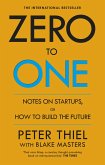Robert L. Heath, Michael J. Palenchar
Strategic Issues Management
Organizations and Public Policy Challenges
Robert L. Heath, Michael J. Palenchar
Strategic Issues Management
Organizations and Public Policy Challenges
- Gebundenes Buch
- Merkliste
- Auf die Merkliste
- Bewerten Bewerten
- Teilen
- Produkt teilen
- Produkterinnerung
- Produkterinnerung
By exploring the communication options that organizations can employ in their stewardship to address crucial public policy options and engage in collaborative decision making, Strategic Issues Management gives students practical, actionable guidance. Issues management is vital to an organization's strategic management. It entails understanding and achieving high standards of corporate responsibility by listening to the opinions of key members of the public.
Strategic Issues Management explores the strategic planning options that organizations can employ to address crucial public policy…mehr
Andere Kunden interessierten sich auch für
![Zero to One Zero to One]() Peter ThielZero to One12,99 €
Peter ThielZero to One12,99 €![Contemporary Issues in Strategic Management Contemporary Issues in Strategic Management]() Paul PhillipsContemporary Issues in Strategic Management198,99 €
Paul PhillipsContemporary Issues in Strategic Management198,99 €![Governance and Management of Sustainable Innovation Governance and Management of Sustainable Innovation]() Governance and Management of Sustainable Innovation123,99 €
Governance and Management of Sustainable Innovation123,99 €![Methodological issues of strategic management accounting and analysis Methodological issues of strategic management accounting and analysis]() Bakhodir KhasanovMethodological issues of strategic management accounting and analysis42,99 €
Bakhodir KhasanovMethodological issues of strategic management accounting and analysis42,99 €![Sustainability and Social Responsibility: Regulation and Reporting Sustainability and Social Responsibility: Regulation and Reporting]() Sustainability and Social Responsibility: Regulation and Reporting155,99 €
Sustainability and Social Responsibility: Regulation and Reporting155,99 €![Asian Tourism Sustainability Asian Tourism Sustainability]() Asian Tourism Sustainability108,99 €
Asian Tourism Sustainability108,99 €![Sustainability and Social Responsibility: Regulation and Reporting Sustainability and Social Responsibility: Regulation and Reporting]() Sustainability and Social Responsibility: Regulation and Reporting155,99 €
Sustainability and Social Responsibility: Regulation and Reporting155,99 €-
-
-
By exploring the communication options that organizations can employ in their stewardship to address crucial public policy options and engage in collaborative decision making, Strategic Issues Management gives students practical, actionable guidance. Issues management is vital to an organization's strategic management. It entails understanding and achieving high standards of corporate responsibility by listening to the opinions of key members of the public.
Strategic Issues Management explores the strategic planning options that organizations can employ to address crucial public policy issues, engage in collaborative decision making, get the organization's "house" in order, engage in tough defense and smart offense, and monitor opinion changes that affect public policy. In this fully updated Second Edition, authors Robert L. Heath and Michael J. Palenchar offer practical, actionable guidance that readers can apply to organizations from large Fortune 500 companies to nongovernmental organizations and start-up high tech companies.
Hinweis: Dieser Artikel kann nur an eine deutsche Lieferadresse ausgeliefert werden.
Strategic Issues Management explores the strategic planning options that organizations can employ to address crucial public policy issues, engage in collaborative decision making, get the organization's "house" in order, engage in tough defense and smart offense, and monitor opinion changes that affect public policy. In this fully updated Second Edition, authors Robert L. Heath and Michael J. Palenchar offer practical, actionable guidance that readers can apply to organizations from large Fortune 500 companies to nongovernmental organizations and start-up high tech companies.
Hinweis: Dieser Artikel kann nur an eine deutsche Lieferadresse ausgeliefert werden.
Produktdetails
- Produktdetails
- Verlag: Sage Publications, Inc
- Artikelnr. des Verlages: B52107C
- 2. Auflage
- Seitenzahl: 426
- Erscheinungstermin: 23. September 2008
- Englisch
- Abmessung: 235mm x 157mm x 27mm
- Gewicht: 764g
- ISBN-13: 9781412952101
- ISBN-10: 1412952107
- Artikelnr.: 24394450
- Herstellerkennzeichnung
- Libri GmbH
- Europaallee 1
- 36244 Bad Hersfeld
- gpsr@libri.de
- Verlag: Sage Publications, Inc
- Artikelnr. des Verlages: B52107C
- 2. Auflage
- Seitenzahl: 426
- Erscheinungstermin: 23. September 2008
- Englisch
- Abmessung: 235mm x 157mm x 27mm
- Gewicht: 764g
- ISBN-13: 9781412952101
- ISBN-10: 1412952107
- Artikelnr.: 24394450
- Herstellerkennzeichnung
- Libri GmbH
- Europaallee 1
- 36244 Bad Hersfeld
- gpsr@libri.de
Robert L. Heath, professor emeritus of communication at the University of Houston, is an internationally recognized authority on public relations, crisis communication, issues management, risk communication, and business-to-business communication. He has published many award-winning books, including The SAGE Handbook of Public Relations (2010), Handbook of Risk and Crisis Communication (2009), Strategic Issues Management (2nd ed., 2009), Rhetorical and Critical Approaches to Public Relations II (2009), and Terrorism: Communication and Rhetorical Perspectives (2008). Heath has 3 decades¿ experience in corporate communication and positioning research. He has conducted research on risks related to various hazards, including those associated with chemical manufacturing and community right-to-know-key themes in community relations. In addition, he has published more than 100 chapters and articles and serves on the editorial and reviewer panels of several premier academic journals. He has received many honors from public relations professionals and academic associations and has lectured nationally and internationally on a wide array of topics.
1. A Foundation of Community
Vignette: British Petroleum--Enlightened Leader or Lightning Rod?
Chapter Goals
Historical Evolution
SIM: Strategic Issues Management Defined
SIM: Stakeholders/Stakeseekers
SIM: Bringing More Than Communication
SIM: Cornerstone of Strategic Business Planning
SIM: Advocacy, Dialogue, and Collaborative Decision Making
Conclusion
SIM Challenge: CSR and Long-Term Planning
Summary Questions
2. Historical Foundations
Vignette: Westinghouse Versus Edison
Chapter Goals
Opinions Shape Operating Environments
Argument Structure in Public Policy Debate
Robber Barons and the Making of Mass Production Society
The Great Depression and the Redemption of Capitalism
Dissent Flowers in the 1960s
The Present and the Future
Conclusion
SIM Challenge: Science or Sham?
Summary Questions
3. Scouting the Terrain
Vignette: The Greening of Nuclear Power
Chapter Goals
Things Go Bump in the Dark
Logics of Issues Monitoring
The Systematic Stages of Issues Monitoring
Creating an Issues Monitoring and Analysis Team
Issue Content: Basis for Issues Analysis
Conclusion
SIM Challenge: NAACP and Issues Monitoring
Summary Questions
4. Corporate Social Responsibility (CSR)
Vignette: Wal-Mart's Makeover?
Chapter Goals
Mutual Interests: The Basis of Corporate Responsibility
Standards of Corporate Responsibility: A Rhetorical Rationale
Changing Organizational Policies: Getting the House in Order
Corporate Responsibility Partnerships: Communicating Ethical Performance
Conclusion
SIM Challenge: Global Warming
Summary Questions
5. Special Interest Activists as Foes or Allies
Vignette: Fast Food--A Lightning Rod for Big Food Protest
Chapter Goals
Moral Outrage
Power Resource Management
Strain: Nexus of Issues, Risk, and Crisis
Stages of Activism
Incremental Erosion
Fostering Mutual Interests Instead of Antagonism
Conclusion
SIM Challenge: Is Clean Energy an Oxymoron?
Summary Questions
6. Issues Communication
Vignettes: Activists Speak With Many Tools
Chapter Goals
The Issue of Issues Communication
Narrative Theory
The Good Organization Communicating Well
Images and Issues: Complements and Counterparts
Framing: Giving Issues Argumentative Context
Media Effects in a Multitiered Society
Communication Technology and Issues Communication
Issues Communication as Argument
Conclusion
SIM Challenge: Voice of a Trade Association
Summary Questions
7. Obligations and Constraints on Issues Communication
Vignette: Corporate Speech--Free, Free for Some, or Not at All?
Chapter Goals
Legislative, Judicial, and Regulatory Constraints on Issues Communication
The Rationale for Organizations Speaking as Citizens
Federal Constraint
Conclusion
SIM Challenge: Looking to the Future
Summary Questions
8. Issues Management and Crisis Communication
Vignette: It Takes Two to Tango
Chapter Goals
Crisis Management: The Search for Control
Prevent a Crisis From Becoming an Issue
Conclusion
SIM Challenge: Can a Crisis Be Prevented From Exploding Into an Issue?
Summary Questions
9. Issues Management and Risk Communication
Vignette: Risk, Risk Everywhere
Chapter Goals
Community Right to Know
The Difficulties of Risk Assessment
Risk Management and Communication Approaches
SIM¿s Approach to Risk Communication
Risk and Crisis Communication Working Together
Conclusion
SIM Challenge: Reality List
Summary Questions
10. Brand Equity and Organizational Reputation
Vignettes: Proactive Versus Reactive
Chapter Goals
Corporate Branding
Brand Equity: Many Faces and Definitions
Brand Attributes and Attitude Theory
Logics of Brand Equity
Brand Equity and Crisis
Brand Equity and Risk
SIM Challenge: Corporate Responsibility and Long-Term Planning
A Brand Equity Case Study: Coors Boycott in the 1970s
Summary Questions
Vignette: British Petroleum--Enlightened Leader or Lightning Rod?
Chapter Goals
Historical Evolution
SIM: Strategic Issues Management Defined
SIM: Stakeholders/Stakeseekers
SIM: Bringing More Than Communication
SIM: Cornerstone of Strategic Business Planning
SIM: Advocacy, Dialogue, and Collaborative Decision Making
Conclusion
SIM Challenge: CSR and Long-Term Planning
Summary Questions
2. Historical Foundations
Vignette: Westinghouse Versus Edison
Chapter Goals
Opinions Shape Operating Environments
Argument Structure in Public Policy Debate
Robber Barons and the Making of Mass Production Society
The Great Depression and the Redemption of Capitalism
Dissent Flowers in the 1960s
The Present and the Future
Conclusion
SIM Challenge: Science or Sham?
Summary Questions
3. Scouting the Terrain
Vignette: The Greening of Nuclear Power
Chapter Goals
Things Go Bump in the Dark
Logics of Issues Monitoring
The Systematic Stages of Issues Monitoring
Creating an Issues Monitoring and Analysis Team
Issue Content: Basis for Issues Analysis
Conclusion
SIM Challenge: NAACP and Issues Monitoring
Summary Questions
4. Corporate Social Responsibility (CSR)
Vignette: Wal-Mart's Makeover?
Chapter Goals
Mutual Interests: The Basis of Corporate Responsibility
Standards of Corporate Responsibility: A Rhetorical Rationale
Changing Organizational Policies: Getting the House in Order
Corporate Responsibility Partnerships: Communicating Ethical Performance
Conclusion
SIM Challenge: Global Warming
Summary Questions
5. Special Interest Activists as Foes or Allies
Vignette: Fast Food--A Lightning Rod for Big Food Protest
Chapter Goals
Moral Outrage
Power Resource Management
Strain: Nexus of Issues, Risk, and Crisis
Stages of Activism
Incremental Erosion
Fostering Mutual Interests Instead of Antagonism
Conclusion
SIM Challenge: Is Clean Energy an Oxymoron?
Summary Questions
6. Issues Communication
Vignettes: Activists Speak With Many Tools
Chapter Goals
The Issue of Issues Communication
Narrative Theory
The Good Organization Communicating Well
Images and Issues: Complements and Counterparts
Framing: Giving Issues Argumentative Context
Media Effects in a Multitiered Society
Communication Technology and Issues Communication
Issues Communication as Argument
Conclusion
SIM Challenge: Voice of a Trade Association
Summary Questions
7. Obligations and Constraints on Issues Communication
Vignette: Corporate Speech--Free, Free for Some, or Not at All?
Chapter Goals
Legislative, Judicial, and Regulatory Constraints on Issues Communication
The Rationale for Organizations Speaking as Citizens
Federal Constraint
Conclusion
SIM Challenge: Looking to the Future
Summary Questions
8. Issues Management and Crisis Communication
Vignette: It Takes Two to Tango
Chapter Goals
Crisis Management: The Search for Control
Prevent a Crisis From Becoming an Issue
Conclusion
SIM Challenge: Can a Crisis Be Prevented From Exploding Into an Issue?
Summary Questions
9. Issues Management and Risk Communication
Vignette: Risk, Risk Everywhere
Chapter Goals
Community Right to Know
The Difficulties of Risk Assessment
Risk Management and Communication Approaches
SIM¿s Approach to Risk Communication
Risk and Crisis Communication Working Together
Conclusion
SIM Challenge: Reality List
Summary Questions
10. Brand Equity and Organizational Reputation
Vignettes: Proactive Versus Reactive
Chapter Goals
Corporate Branding
Brand Equity: Many Faces and Definitions
Brand Attributes and Attitude Theory
Logics of Brand Equity
Brand Equity and Crisis
Brand Equity and Risk
SIM Challenge: Corporate Responsibility and Long-Term Planning
A Brand Equity Case Study: Coors Boycott in the 1970s
Summary Questions
1. A Foundation of Community
Vignette: British Petroleum--Enlightened Leader or Lightning Rod?
Chapter Goals
Historical Evolution
SIM: Strategic Issues Management Defined
SIM: Stakeholders/Stakeseekers
SIM: Bringing More Than Communication
SIM: Cornerstone of Strategic Business Planning
SIM: Advocacy, Dialogue, and Collaborative Decision Making
Conclusion
SIM Challenge: CSR and Long-Term Planning
Summary Questions
2. Historical Foundations
Vignette: Westinghouse Versus Edison
Chapter Goals
Opinions Shape Operating Environments
Argument Structure in Public Policy Debate
Robber Barons and the Making of Mass Production Society
The Great Depression and the Redemption of Capitalism
Dissent Flowers in the 1960s
The Present and the Future
Conclusion
SIM Challenge: Science or Sham?
Summary Questions
3. Scouting the Terrain
Vignette: The Greening of Nuclear Power
Chapter Goals
Things Go Bump in the Dark
Logics of Issues Monitoring
The Systematic Stages of Issues Monitoring
Creating an Issues Monitoring and Analysis Team
Issue Content: Basis for Issues Analysis
Conclusion
SIM Challenge: NAACP and Issues Monitoring
Summary Questions
4. Corporate Social Responsibility (CSR)
Vignette: Wal-Mart's Makeover?
Chapter Goals
Mutual Interests: The Basis of Corporate Responsibility
Standards of Corporate Responsibility: A Rhetorical Rationale
Changing Organizational Policies: Getting the House in Order
Corporate Responsibility Partnerships: Communicating Ethical Performance
Conclusion
SIM Challenge: Global Warming
Summary Questions
5. Special Interest Activists as Foes or Allies
Vignette: Fast Food--A Lightning Rod for Big Food Protest
Chapter Goals
Moral Outrage
Power Resource Management
Strain: Nexus of Issues, Risk, and Crisis
Stages of Activism
Incremental Erosion
Fostering Mutual Interests Instead of Antagonism
Conclusion
SIM Challenge: Is Clean Energy an Oxymoron?
Summary Questions
6. Issues Communication
Vignettes: Activists Speak With Many Tools
Chapter Goals
The Issue of Issues Communication
Narrative Theory
The Good Organization Communicating Well
Images and Issues: Complements and Counterparts
Framing: Giving Issues Argumentative Context
Media Effects in a Multitiered Society
Communication Technology and Issues Communication
Issues Communication as Argument
Conclusion
SIM Challenge: Voice of a Trade Association
Summary Questions
7. Obligations and Constraints on Issues Communication
Vignette: Corporate Speech--Free, Free for Some, or Not at All?
Chapter Goals
Legislative, Judicial, and Regulatory Constraints on Issues Communication
The Rationale for Organizations Speaking as Citizens
Federal Constraint
Conclusion
SIM Challenge: Looking to the Future
Summary Questions
8. Issues Management and Crisis Communication
Vignette: It Takes Two to Tango
Chapter Goals
Crisis Management: The Search for Control
Prevent a Crisis From Becoming an Issue
Conclusion
SIM Challenge: Can a Crisis Be Prevented From Exploding Into an Issue?
Summary Questions
9. Issues Management and Risk Communication
Vignette: Risk, Risk Everywhere
Chapter Goals
Community Right to Know
The Difficulties of Risk Assessment
Risk Management and Communication Approaches
SIM¿s Approach to Risk Communication
Risk and Crisis Communication Working Together
Conclusion
SIM Challenge: Reality List
Summary Questions
10. Brand Equity and Organizational Reputation
Vignettes: Proactive Versus Reactive
Chapter Goals
Corporate Branding
Brand Equity: Many Faces and Definitions
Brand Attributes and Attitude Theory
Logics of Brand Equity
Brand Equity and Crisis
Brand Equity and Risk
SIM Challenge: Corporate Responsibility and Long-Term Planning
A Brand Equity Case Study: Coors Boycott in the 1970s
Summary Questions
Vignette: British Petroleum--Enlightened Leader or Lightning Rod?
Chapter Goals
Historical Evolution
SIM: Strategic Issues Management Defined
SIM: Stakeholders/Stakeseekers
SIM: Bringing More Than Communication
SIM: Cornerstone of Strategic Business Planning
SIM: Advocacy, Dialogue, and Collaborative Decision Making
Conclusion
SIM Challenge: CSR and Long-Term Planning
Summary Questions
2. Historical Foundations
Vignette: Westinghouse Versus Edison
Chapter Goals
Opinions Shape Operating Environments
Argument Structure in Public Policy Debate
Robber Barons and the Making of Mass Production Society
The Great Depression and the Redemption of Capitalism
Dissent Flowers in the 1960s
The Present and the Future
Conclusion
SIM Challenge: Science or Sham?
Summary Questions
3. Scouting the Terrain
Vignette: The Greening of Nuclear Power
Chapter Goals
Things Go Bump in the Dark
Logics of Issues Monitoring
The Systematic Stages of Issues Monitoring
Creating an Issues Monitoring and Analysis Team
Issue Content: Basis for Issues Analysis
Conclusion
SIM Challenge: NAACP and Issues Monitoring
Summary Questions
4. Corporate Social Responsibility (CSR)
Vignette: Wal-Mart's Makeover?
Chapter Goals
Mutual Interests: The Basis of Corporate Responsibility
Standards of Corporate Responsibility: A Rhetorical Rationale
Changing Organizational Policies: Getting the House in Order
Corporate Responsibility Partnerships: Communicating Ethical Performance
Conclusion
SIM Challenge: Global Warming
Summary Questions
5. Special Interest Activists as Foes or Allies
Vignette: Fast Food--A Lightning Rod for Big Food Protest
Chapter Goals
Moral Outrage
Power Resource Management
Strain: Nexus of Issues, Risk, and Crisis
Stages of Activism
Incremental Erosion
Fostering Mutual Interests Instead of Antagonism
Conclusion
SIM Challenge: Is Clean Energy an Oxymoron?
Summary Questions
6. Issues Communication
Vignettes: Activists Speak With Many Tools
Chapter Goals
The Issue of Issues Communication
Narrative Theory
The Good Organization Communicating Well
Images and Issues: Complements and Counterparts
Framing: Giving Issues Argumentative Context
Media Effects in a Multitiered Society
Communication Technology and Issues Communication
Issues Communication as Argument
Conclusion
SIM Challenge: Voice of a Trade Association
Summary Questions
7. Obligations and Constraints on Issues Communication
Vignette: Corporate Speech--Free, Free for Some, or Not at All?
Chapter Goals
Legislative, Judicial, and Regulatory Constraints on Issues Communication
The Rationale for Organizations Speaking as Citizens
Federal Constraint
Conclusion
SIM Challenge: Looking to the Future
Summary Questions
8. Issues Management and Crisis Communication
Vignette: It Takes Two to Tango
Chapter Goals
Crisis Management: The Search for Control
Prevent a Crisis From Becoming an Issue
Conclusion
SIM Challenge: Can a Crisis Be Prevented From Exploding Into an Issue?
Summary Questions
9. Issues Management and Risk Communication
Vignette: Risk, Risk Everywhere
Chapter Goals
Community Right to Know
The Difficulties of Risk Assessment
Risk Management and Communication Approaches
SIM¿s Approach to Risk Communication
Risk and Crisis Communication Working Together
Conclusion
SIM Challenge: Reality List
Summary Questions
10. Brand Equity and Organizational Reputation
Vignettes: Proactive Versus Reactive
Chapter Goals
Corporate Branding
Brand Equity: Many Faces and Definitions
Brand Attributes and Attitude Theory
Logics of Brand Equity
Brand Equity and Crisis
Brand Equity and Risk
SIM Challenge: Corporate Responsibility and Long-Term Planning
A Brand Equity Case Study: Coors Boycott in the 1970s
Summary Questions








